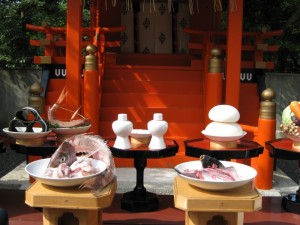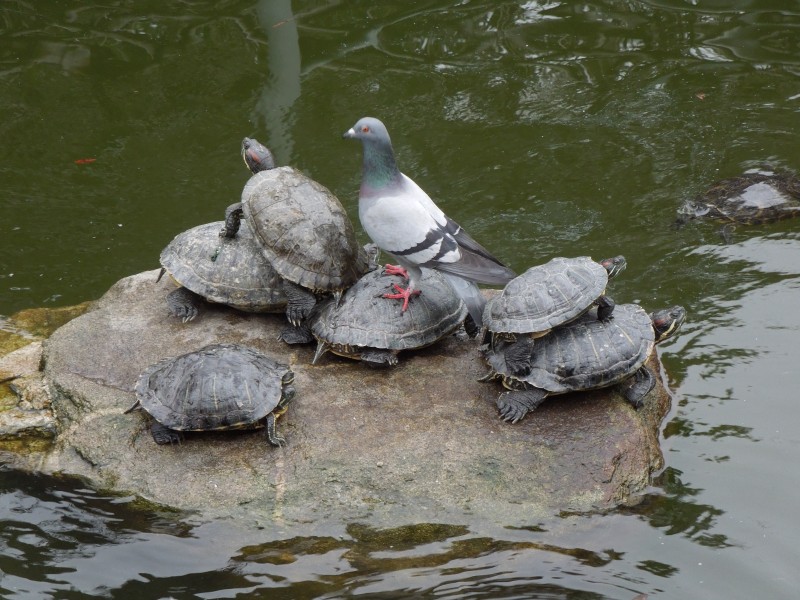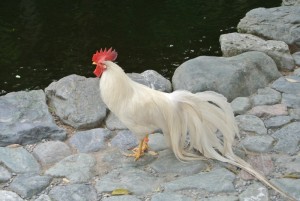As someone distressed by the appalling treatment of animals by human beings (factory farming being the most egregious example), it saddens me that modern Shinto shows so little interest in the subject. Animal guardians serve the kami, and horses act as loyal mounts. Yet there is precious little love expended in return. There are whaling shrines, for instance, where the focus is solely on the safety of the hunters not the hunted. There is a Shinto festival with horrific treatment of horses. And not once have I heard a Shinto spokesman speak out against cruelty to animals, such as the notorious slaughter of dolphins at Taiji.

Sliced fish offerings at Yoshida Jinja in Kyoto
In the past animals such as horses were sacrificed as offerings for the kami. Fish still are, and at Suwa Taisha there’s ritual slaughter of deer. It’s Japan’s other main religion to which one has to turn for evidence of a concern with animal rights. The Buddhist tradition of compassion for living beings has played a significant role in the country’s history and first became evident with a decree by Emperor Temmu in the seventh century.
There will be a Noh play on Oct 3 (14.00 – ) at Kyoto Kanze Kaikan (075 771 6114) which illustrates the profound effect Buddhism had on animal rights. It’s called Utou, or murrelet, and concerns a hunter who imitates the parent bird calling its child and then kills the young. Karma catches up with the cruel hunter, and after his death he is sent to hell where he in turn is tortured by utou and their fellow hawks. He is prevented too from seeing his own child. In the play his ghost asks a travelling monk to pray for him and save him from the torture.
The following account comes from Nipponia no. 36 (March, 2006) and suggests that in the past Shinto’s concern for purity was part of a widespread reluctance to eat meat. It’s the first time I’ve heard of this and I’m uncertain if it’s historically accurate. If it is, then there’s clear precedence for the encouragement of vegetarianism.
The first law prohibiting meat eating was issued in the year 675, a little more than 100 years after the arrival of Buddhism. In the 7th and 8th centuries, when a new emperor came to the throne he would issue an Imperial edict forbidding meat consumption. This was because, according to Buddhist belief, killing animals is wrong. The fact that these edicts were issued from time to time indicates that some found it hard to give up eating meat. But by around the 10th century just about everyone had stopped eating it.
A white rooster at Ise Jingu, safe from carnivores, serves as an attendant to Amaterasu
In China and the Korean peninsula, the Buddhist clergy were not allowed to eat meat or fish, but in Japan even ordinary people did not eat meat. This was partly because of Buddhism, and partly because the indigenous religion, Shinto, considered that eating the flesh of animals was unclean.
But the rule extended only to meat from mammals, not seafood. Whales are mammals, but the common folk thought of them as big fish and there was no prohibition against killing and eating them. Wild birds were also eaten. There was a belief that chickens and roosters were messengers working for the Shinto gods, and their meat and eggs were not eaten until the 15th century.

Living in harmony
In Ghostly Japan (1899), Lafcadio Hearn wrote as follows concerning Buddhist compassion with animals: “This custom of praying for the souls of animals is by no means general. But I have seen in the western provinces several burials of domestic animals at which such prayers were said. After the earth was filled in, some incense-rods were lighted above the grave in each instance, and the prayers were repeated in a whisper. A friend in the capital sends me the following curious information: ‘At the Eko-in temple in Tokyo prayers are offered up every morning for the souls of certain animals whose ihai [mortuary tablets] are preserved in the building. A fee of thirty sen will procure burial in the temple-ground and a short service for any small domestic pet.’ Doubtless similar temples exist elsewhere. Certainly no one capable of affection for our dumb friends and servants can mock these gentle customs.”


Leave a Reply